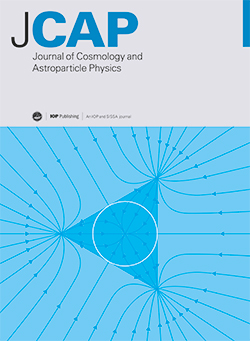宇宙空洞为何重要:重子物理学的缓解
IF 5.3
2区 物理与天体物理
Q1 ASTRONOMY & ASTROPHYSICS
Journal of Cosmology and Astroparticle Physics
Pub Date : 2024-08-29
DOI:10.1088/1475-7516/2024/08/065
引用次数: 0
摘要
我们利用最先进的流体力学和纯暗物质模拟的 Magneticum 套件,在同类最高分辨率的研究中调查重子物理学对宇宙空洞的影响。这包括空洞的大小、形状和内部密度分布,以及由(亚)光环、重子和冷暗物质粒子追踪的它们的径向密度和速度剖面。我们的研究结果显示了一些观测上不明显的影响,这些影响会随着空洞内部密度的增加而略微增大,并且只与几个 Mpc 的尺度相关。最值得注意的是,我们发现重子和冷暗物质在光环定义的空洞周围的分布存在偏差,这与弱透镜研究有关。与此相反,我们发现在冷暗物质以及固定示踪密度的光晕中发现的空洞在流体力学模拟和纯暗物质模拟之间表现出几乎无差别的分布和轮廓,这巩固了后者的普遍性和稳健性,以便在即将进行的巡天观测中将空洞统计与观测结果进行比较。这证实了空洞是宇宙网中受重子物理影响最小的组成部分,进一步增强了它们作为宇宙学探测器的用途。本文章由计算机程序翻译,如有差异,请以英文原文为准。
Why cosmic voids matter: mitigation of baryonic physics
We utilize the Magneticum suite of state-of-the-art hydrodynamical, as well as dark-matter-only simulations to investigate the effects of baryonic physics on cosmic voids in the highest-resolution study of its kind. This includes the size, shape and inner density distributions of voids, as well as their radial density and velocity profiles traced by (sub-) halos, baryonic and cold dark matter particles. Our results reveal observationally insignificant effects that slightly increase with the inner densities of voids and are exclusively relevant on scales of only a few Mpc. Most notably, we identify deviations in the distributions of baryons and cold dark matter around halo-defined voids, relevant for weak lensing studies. In contrast, we find that voids identified in cold dark matter, as well as in halos of fixed tracer density exhibit nearly indistinguishable distributions and profiles between hydrodynamical and dark-matter-only simulations, consolidating the universality and robustness of the latter for comparisons of void statistics with observations in upcoming surveys. This corroborates that voids are the components of the cosmic web that are least affected by baryonic physics, further enhancing their use as cosmological probes.
求助全文
通过发布文献求助,成功后即可免费获取论文全文。
去求助
来源期刊

Journal of Cosmology and Astroparticle Physics
地学天文-天文与天体物理
CiteScore
10.20
自引率
23.40%
发文量
632
审稿时长
1 months
期刊介绍:
Journal of Cosmology and Astroparticle Physics (JCAP) encompasses theoretical, observational and experimental areas as well as computation and simulation. The journal covers the latest developments in the theory of all fundamental interactions and their cosmological implications (e.g. M-theory and cosmology, brane cosmology). JCAP''s coverage also includes topics such as formation, dynamics and clustering of galaxies, pre-galactic star formation, x-ray astronomy, radio astronomy, gravitational lensing, active galactic nuclei, intergalactic and interstellar matter.
 求助内容:
求助内容: 应助结果提醒方式:
应助结果提醒方式:


